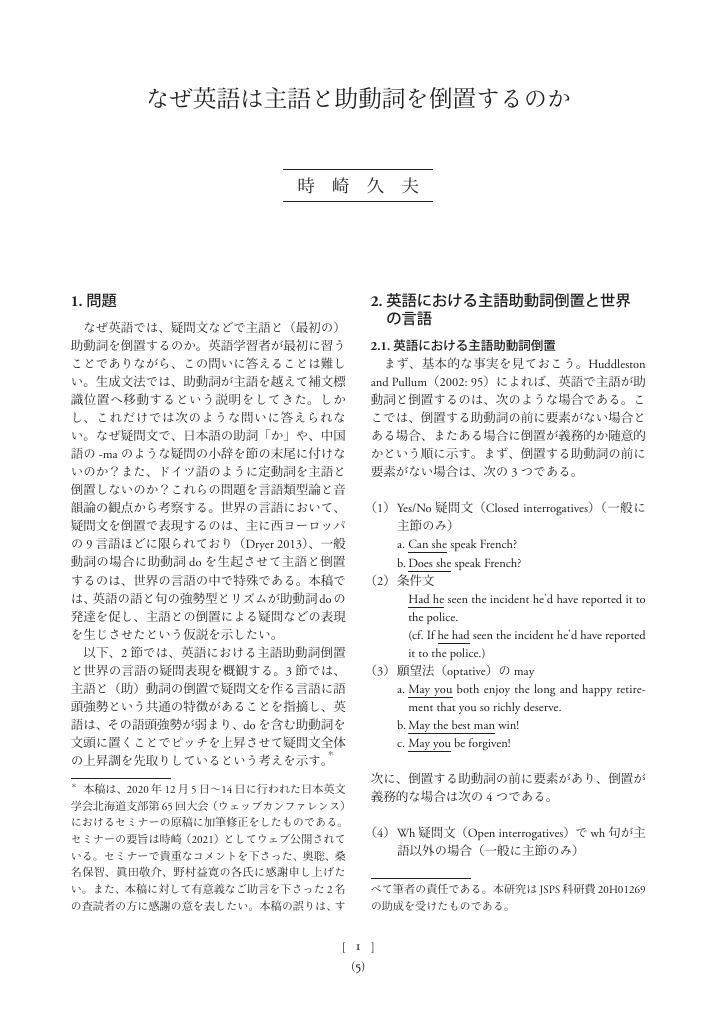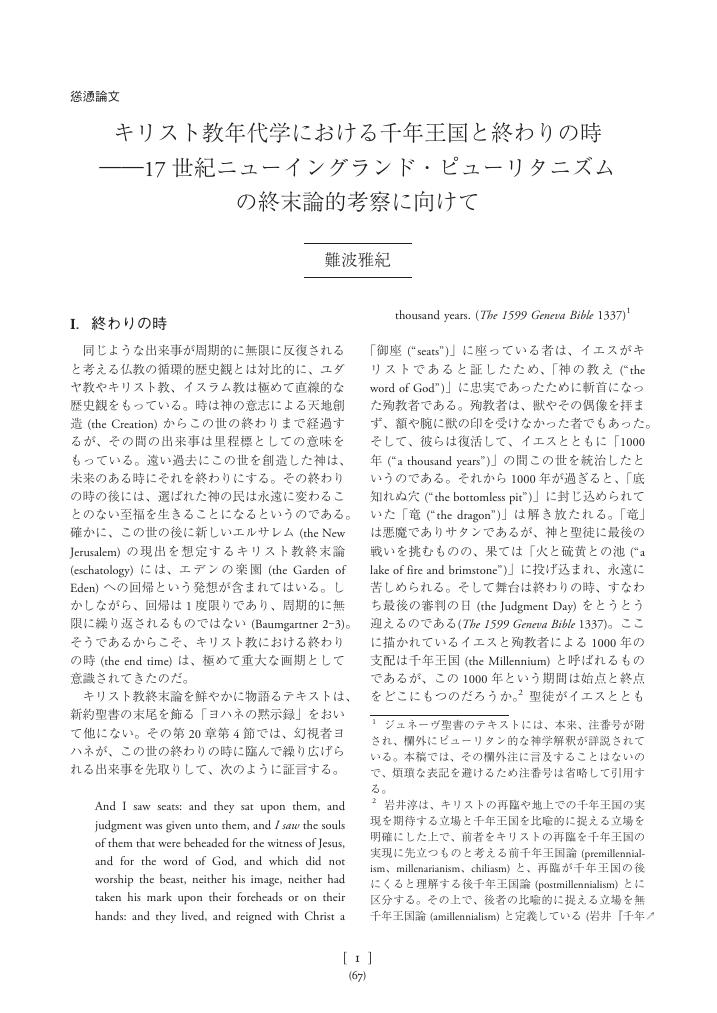13 0 0 0 OA 大名力著『英語の文字・綴り・発音のしくみ』
- 著者
- 寺澤 盾
- 出版者
- 一般財団法人 日本英文学会
- 雑誌
- 英文学研究 (ISSN:00393649)
- 巻号頁・発行日
- vol.93, pp.205-211, 2016 (Released:2017-03-17)
- 著者
- 藤野 功一
- 出版者
- 一般財団法人 日本英文学会
- 雑誌
- 英文学研究 支部統合号 (ISSN:18837115)
- 巻号頁・発行日
- vol.12, pp.311-321, 2019 (Released:2020-12-05)
7 0 0 0 OA なぜ英語は主語と助動詞を倒置するのか
- 著者
- 時崎 久夫
- 出版者
- 一般財団法人 日本英文学会
- 雑誌
- 英文学研究 支部統合号 (ISSN:18837115)
- 巻号頁・発行日
- vol.14, pp.5-15, 2022 (Released:2022-02-13)
7 0 0 0 OA 川端康雄著 『ジョージ・オーウェル ── 「人間らしさ」への讃歌』
- 著者
- 渡辺 愛子
- 出版者
- 一般財団法人 日本英文学会
- 雑誌
- 英文学研究 (ISSN:00393649)
- 巻号頁・発行日
- vol.99, pp.49-54, 2022 (Released:2023-03-02)
- 著者
- 有馬 哲夫
- 出版者
- 一般財団法人 日本英文学会
- 雑誌
- 英文学研究 (ISSN:00393649)
- 巻号頁・発行日
- vol.59, no.2, pp.394, 1982-12-01 (Released:2017-04-10)
- 著者
- 高橋 愛
- 出版者
- 一般財団法人 日本英文学会
- 雑誌
- 英文学研究 支部統合号 (ISSN:18837115)
- 巻号頁・発行日
- vol.7, pp.229-236, 2015
Moby-Dick has been considered to be the most masculine of Herman Melville's novels. However, few studies have extensively considered the masculinity of those on board the Pequod despite the possibility that Melville had worked hard to express masculinities that deviated from the norms of American society in the nineteenth century. This paper discusses Queequeg, a harpooner from the South Seas, as a character onto whom Melville projected a facet of his multiple ideas of masculinity, by examining his body and his behaviors. First, Queequeg's race and ethnicity are ambiguous, though he is introduced as a Pacific Islander. His tattooed body characterizes him as non-white, but at the same time he transgresses the color line with his phrenologically excellent skull. His tattoos do not reveal any ethic characteristics, though it is said that he is based on a real Maori chief. Additionally, Queequeg's sexuality and gender are also ambiguous. He has a cordial friendship with Ishmale, a common sailor and the narrator of the novel. However, their friendship often seems too sensual to presume that they are just friends: Queequeg caresses his friend many times and his actions anticipate the homoerotic ecstasy that Ishmael experiences later. There also seems to be indications that Queequeg is transgender: for instance, his affectionate huging of Ishmael and his rescue of Tashtego, another harpooner. Given these points, Queequeg seems to be portrayed as an amorphous man who transgresses the boundaries of race, ethnicity, sexuality, and gender. It is possible that his amorphous self is a projected image of what Melville regards as masculine.
- 著者
- 星 久美子
- 出版者
- 一般財団法人 日本英文学会
- 雑誌
- 英文学研究 (ISSN:00393649)
- 巻号頁・発行日
- vol.95, pp.96, 2018 (Released:2018-12-31)
5 0 0 0 OA 英語縮約関係節の構造について
- 著者
- 鈴木 達也
- 出版者
- 一般財団法人 日本英文学会
- 雑誌
- 英文学研究 支部統合号 (ISSN:18837115)
- 巻号頁・発行日
- vol.10, pp.139, 2018 (Released:2019-02-16)
5 0 0 0 OA 謎解きナボコフ『ディフェンス』モラルをめぐるゲーム
- 著者
- 秋草 俊一郎
- 出版者
- 一般財団法人 日本英文学会
- 雑誌
- 英文学研究 (ISSN:00393649)
- 巻号頁・発行日
- vol.85, pp.73-88, 2008-11-28 (Released:2017-04-10)
5 0 0 0 OA ロマンシング・ロンドン : エリザベス朝末期における大衆騎士道ロマンス
- 著者
- 竹村 はるみ
- 出版者
- 一般財団法人 日本英文学会
- 雑誌
- 英文学研究 (ISSN:00393649)
- 巻号頁・発行日
- vol.81, pp.109-122, 2005-01-20 (Released:2017-04-10)
- 著者
- 難波 雅紀
- 出版者
- 一般財団法人 日本英文学会
- 雑誌
- 英文学研究 支部統合号 (ISSN:18837115)
- 巻号頁・発行日
- vol.9, pp.67-77, 2017 (Released:2017-05-02)
- 著者
- 塚本 聡
- 出版者
- 一般財団法人 日本英文学会
- 雑誌
- 英文学研究 (ISSN:00393649)
- 巻号頁・発行日
- vol.90, pp.155-160, 2013-12-01 (Released:2017-04-10)
- 著者
- 不破 有理
- 出版者
- 一般財団法人 日本英文学会
- 雑誌
- 英文学研究
- 巻号頁・発行日
- vol.68, no.2, 1992
3 0 0 0 OA 感染症の時代に読み直す『ロミオとジュリエット』
- 著者
- 鶴田 学
- 出版者
- 一般財団法人 日本英文学会
- 雑誌
- 英文学研究 支部統合号 (ISSN:18837115)
- 巻号頁・発行日
- vol.14, pp.231-239, 2022 (Released:2022-02-14)
3 0 0 0 OA 語られなかったもう一つのレズビアン・プロット――サラ・ウォーターズの『アフィニティ』
- 著者
- 平林 美都子
- 出版者
- 一般財団法人 日本英文学会
- 雑誌
- 英文学研究 支部統合号 (ISSN:18837115)
- 巻号頁・発行日
- vol.9, pp.115-122, 2017 (Released:2017-05-02)
- 著者
- 石塚 久郎
- 出版者
- 一般財団法人 日本英文学会
- 雑誌
- 英文学研究 (ISSN:00393649)
- 巻号頁・発行日
- vol.99, pp.17-34, 2022 (Released:2023-03-02)
- 著者
- 堀 智弘
- 出版者
- 一般財団法人 日本英文学会
- 雑誌
- 英文学研究 支部統合号 (ISSN:18837115)
- 巻号頁・発行日
- vol.11, pp.63-70, 2018 (Released:2019-02-07)
3 0 0 0 感染症の時代に読み直す『ロミオとジュリエット』
- 著者
- 鶴田 学
- 出版者
- 一般財団法人 日本英文学会
- 雑誌
- 英文学研究 支部統合号 (ISSN:18837115)
- 巻号頁・発行日
- vol.14, pp.231-239, 2022
3 0 0 0 OA 河野継代著『英語の関係節』
- 著者
- 佐々木 一隆
- 出版者
- 一般財団法人 日本英文学会
- 雑誌
- 英文学研究 (ISSN:00393649)
- 巻号頁・発行日
- vol.93, pp.184-189, 2016 (Released:2017-03-17)
- 著者
- 舌津 智之
- 出版者
- 一般財団法人 日本英文学会
- 雑誌
- 英文学研究 (ISSN:00393649)
- 巻号頁・発行日
- vol.84, pp.244-248, 2007-11-20 (Released:2017-04-10)















